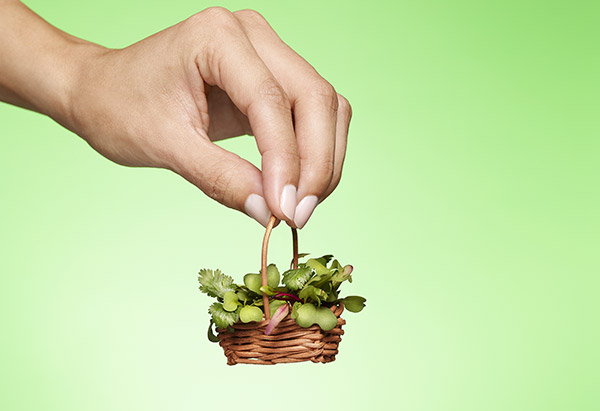These seedlings prove that good things can come in extremely small packages.

Photo: Adam Voorhes
Every few years it seems like a new leafy veggie becomes the darling of the farmers' market—first Swiss chard, then kale, and now...microgreens. Harvested when they're just seven to 14 days old, these pint-size leaves can be far more nutrient dense than their full-grown counterparts, according to a recent study done in collaboration with the U.S. Department of Agriculture and published in the Journal of Agricultural and Food Chemistry. "Plants use stored nutrients to grow, so plucking the tiny seedlings early means they still have high levels of vitamins and minerals," says study coauthor Zhenlei Xiao. Keep in mind, though, that these mini-me's lack the fiber found in mature plants, so they should supplement the greens you already eat, not replace them. The best part? Thanks to the concentrated flavor of these five diminutive standouts, they elevate meals in taste as well as nutrition.
This fragrant green contains 11 times more lutein and zeaxanthin (nutrients that can reduce the risk of cataracts and age-related vision loss) than the same amount of mature cilantro.
Best with...Latin dishes.
Nicolas Bour, executive chef at Rancho Bernardo Inn in San Diego, suggests a twist on guacamole: Mix 3 ripe avocados with 1 chopped heirloom tomato, ½ chopped red onion and the juice of 2 limes. Add 4 Tbsp. micro cilantro, 8 tsp. olive oil and 4 ounces chilled baby shrimp. Salt to taste; top with ¼ ounce micro cilantro and serve with chips. Serves 4.
These slightly bitter, heart-shaped leaves outshine full-grown cabbage with roughly 260 times the beta-carotene (a precursor to vitamin A that can help protect eyesight) and more than 40 times the vitamin E.
Best with...sweet side dishes, like this simple slaw from Bour.
Combine 2 cups each julienned napa cabbage, red endive, and Fuji apple with a generous dash each of grapeseed oil and sherry vinegar. Sprinkle with ¼ cup micro red cabbage. Serves 4.
Next: The small (spicy) green packed with vitamin C
Micro Cilantro
This fragrant green contains 11 times more lutein and zeaxanthin (nutrients that can reduce the risk of cataracts and age-related vision loss) than the same amount of mature cilantro.
Best with...Latin dishes.
Nicolas Bour, executive chef at Rancho Bernardo Inn in San Diego, suggests a twist on guacamole: Mix 3 ripe avocados with 1 chopped heirloom tomato, ½ chopped red onion and the juice of 2 limes. Add 4 Tbsp. micro cilantro, 8 tsp. olive oil and 4 ounces chilled baby shrimp. Salt to taste; top with ¼ ounce micro cilantro and serve with chips. Serves 4.
Micro Red Cabbage
These slightly bitter, heart-shaped leaves outshine full-grown cabbage with roughly 260 times the beta-carotene (a precursor to vitamin A that can help protect eyesight) and more than 40 times the vitamin E.
Best with...sweet side dishes, like this simple slaw from Bour.
Combine 2 cups each julienned napa cabbage, red endive, and Fuji apple with a generous dash each of grapeseed oil and sherry vinegar. Sprinkle with ¼ cup micro red cabbage. Serves 4.
Next: The small (spicy) green packed with vitamin C
Micro Purple Mustard Green
Just 4 ounces of these greens meet your recommended dietary allowance (RDA) of vitamin C (75 milligrams). Another perk: "These greens are among the tastiest, due to their spicy zing," says Xiao.
Best with...bold-flavored meat that can stand up to spice.
Dan Marquis, executive chef of Quay Restaurant in Chicago, suggests baking 4 pork chops, seasoned with salt and pepper, for 15 minutes at 375 degrees. Top with ½ ounce micro mustard greens and serve with a dollop of mustard and roasted potatoes. Serves 4.
Micro Green Daikon Radish
These sharp, spicy leaves are vitamin E superstars, boasting 165 percent of your RDA per ounce—and helping to shore up your immune system and protect tissues and organs from damage caused by free radicals. By contrast, mature leaves contain only trace amounts of the antioxidant.
Best with...Asian-inspired meals.
Try these Thai noodles from Marquis: Sauté 4 bunches baby bok choy, ½ ounce grated ginger, 6 ounces shiitake mushrooms, and 4 chopped garlic cloves in olive oil. Once the bok choy softens, add 12 ounces cooked rice noodles and 1½ cups peanut sauce. Top with ¼ ounce micro green daikon radish. Serves 4.
Micro Garnet Amaranth
Light red with an earthy, floral flavor, micro garnet amaranth ranks highest in vitamin K among micro greens (with more than 3½ times the amount in mature amaranth). Vitamin K is essential for blood clotting and may reduce the risk of bone fractures.
Best with...grains.
Bour's recipe: Combine 3 cups cooked quinoa with 2 minced shallots and 3 chopped mint leaves in a bowl. Add 1 Tbsp. olive oil. Stir in 2 diced, ripe peaches. Top each serving with ⅛ ounce micro amaranth and drizzle with balsamic vinegar. Serves 4.
More Foods That Deliver Huge Health Benefits




